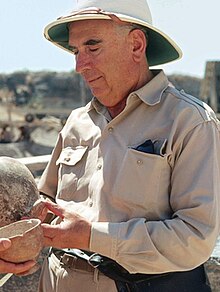Spyridon Marinatos | |
|---|---|
Σπυρίδων Μαρινάτος | |
 Marinatos at Akrotiri in 1968 | |
| Born | Spyridon Nikolaou Marinatos 17 November [O.S. 4 November] 1901 |
| Died | 1 October 1974 (aged 72) Akrotiri, Santorini, Greece |
| Resting place | Akrotiri |
| Education | |
| Known for | Excavations of Akrotiri; theory of the volcanic destruction of Minoan Crete |
| Children | Nanno |
| Honours |
|
| Scientific career | |
| Fields | Archaeology |
| Institutions | |
| Thesis | Ἤ ἀρχαία θαλασσογραφία (Ancient Marine Art) (1925) |
| Doctoral advisor | Georgios Oikomenos |
| Notable students | Stylianos Alexiou |
| Signature | |
Spyridon Marinatos (Greek: Σπυρίδων Μαρινάτος; 17 November [O.S. 4 November] 1901[a] – 1 October 1974) was a Greek archaeologist who specialised in the Bronze Age Minoan and Mycenaean civilizations. He is best known for the excavation of the Minoan site of Akrotiri on Santorini, which he conducted between 1967 and 1974. A recipient of several honours in Greece and abroad, he was considered one of the most important Greek archaeologists of his day.
A native of Kephallonia, Marinatos was educated at the University of Athens, at the Humboldt University of Berlin and at the University of Halle. His early teachers included noted archaeologists such as Panagiotis Kavvadias, Christos Tsountas and Georg Karo. He joined the Greek Archaeological Service in 1919, and spent much of his early career on the island of Crete, where he excavated several Minoan sites, served as director of the Heraklion Museum, and formulated his theory that the collapse of Neopalatial Minoan society had been the result of the eruption of the volcanic island of Santorini around 1600 BCE.
In the 1940s and 1950s, Marinatos surveyed and excavated widely in the region of Messenia in southwest Greece, collaborating with Carl Blegen, who was engaged in the simultaneous excavation of the Palace of Nestor at Pylos. He also discovered and excavated the battlefield of Thermopylae and the Mycenaean cemeteries at Tsepi and Vranas near Marathon in Attica.
Marinatos served three times as head of the Greek Archaeological Service, firstly between 1937 and 1939, secondly between 1955 and 1958, and finally under the military junta which ruled Greece between 1967 and 1974. In the late 1930s, he was close to the quasi-fascist dictatorship of Ioannis Metaxas, under whom he initiated legislation to restrict the roles of women in Greek archaeology, and he was later an enthusiastic supporter of the junta. His leadership of the Archaeological Service has been criticised for its cronyism and for promoting the pursuit of grand discoveries at the expense of good scholarship. Marinatos died while excavating at Akrotiri in 1974, and is buried at the site.
- ^ Kiminas 2009, p. 23.
Cite error: There are <ref group=lower-alpha> tags or {{efn}} templates on this page, but the references will not show without a {{reflist|group=lower-alpha}} template or {{notelist}} template (see the help page).